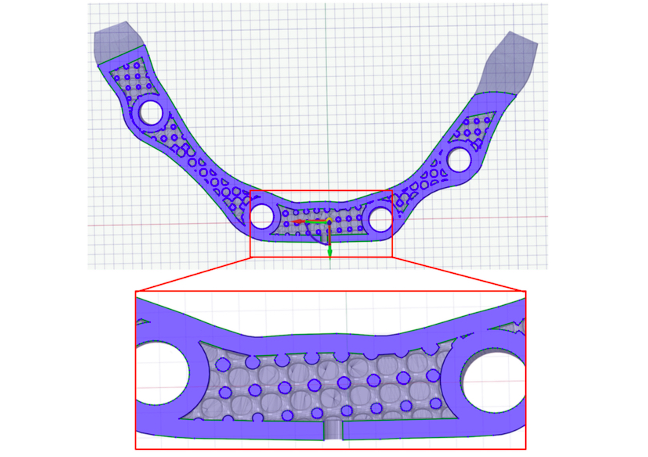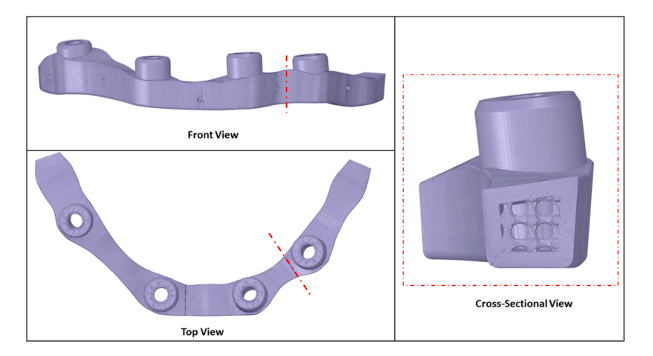Les Kalman is Assistant Professor of Restorative Dentistry and Academic Lead for Continuing Dental Education at Western University’s Schulich School of Medicine & Dentistry. He will be participating in Additive Manufacturing Strategies 2022, Panel 2: Improving the patient experience with 3D printing.
Introduction
Dental implants remain the gold standard for the replacement of a missing tooth or teeth. If all the teeth in one arch are entirely missing (edentulous) then rehabilitation with implants provides patients an improvement in function, aesthetics and quality of life. Implant bars are a predictable and cost-effective option, where the bar supports and retains the denture, instead of resting on the patient’s soft tissues. Implant bars are delivered to patients through a complex clinical workflow and fabricated through subtractive manufacturing or milling. The milling process has its disadvantages, in terms of cost, efficiency and environmental footprint.
As metal additive manufacturing (AM) matures, it presents a novel opportunity for the fabrication of implant bars, which may reduce both the time and cost, ultimately improving the accessibility for the treatment. Moreover, AM may provide a more sustainable approach, especially through a more conservative lattice-structured design, reducing dentistry’s environmental footprint. This report explains our workflow developed for the fabrication of additive manufactured solid & lattice-structured titanium alloy dental implant overdenture bars.
Methods & Materials
Milled Bar
A dental implant metal bar was sourced from Panthera Dental. This bar was part of a patient education model, consisting of the implant bar, model of the patient’s lower jaw (mandible) and the simulated soft tissue (Figure 1). The implant bar was milled from titanium alloy (Ti6Al4V) on a fully robotic CNC machine at a 4.0 manufacturing facility. The bar was monobloc, with no welded areas and no porosity, and had a very accurate and passive fit with the dental implants on the model. The STL file of the bar was provided by Panthera Dental.

Figure 1. Patient soft tissue model with implants and milled dental implant bar.
Design
The implant bar design file (STL) was reviewed by ADEISS (London, Ontario) to evaluate the design for additive manufacturing. Review for AM determined that the STL design required modifications to incorporate through-holes of 2 mm in diameter for implant placement, and the overall implant bar structure needed to be thickened to account for AM post-processing where surface finishing was required.
Two implant bar designs were generated for AM; the first design was a solid structure to replicate a standard implant bar, and the second design incorporated an internal latticed pattern within the bar component. The lattice design was created using standard computer aided design (CAD) software functions, with circular cross-sectional geometry (Ansys Spaceclaim 3D Modeling Software) (Figures 2 and 3). Additionally, for the lattice-designed bars, drainage holes of 0.75 mm diameter were incorporated into the anterior walls, such that non-consolidated powder from the AM process could be cleaned from the samples in post-processing (Figure 3). The final STL designs for AM were confirmed to match the dimensions of a comparative milled bar sample.

Figure 2. Implant bar model with internal lattice pattern. (Image provided by ADEISS Inc., London, ON, Canada)

Figure 3. Implant bar design with circular cross-section internal lattice pattern. (Image provided by ADEISS Inc., London, ON, Canada)
Selective Laser Melting (3D Printing) and Post-Processing
STL designs for AM were prepared for printing in medical-grade titanium alloy (Ti6Al4V). Printing was done using selective laser melting technology with the Renishaw AM 400 system (Renishaw PLS, Gloucestershire, United Kingdom). The 3D printer utilizes alloy powder within the range of 30 – 50 µm in diameter, with a 400W laser of 70 µm diameter, to consolidate the final implant bars within a 250 mm x 250 mm x 250 mm build volume. A total of 18 implant bars (12 solid, 6 internal lattices) were fabricated with machine print time of 7 hours and 6 mins.
Following the printing process, the build plate with implant bars were cleaned using compressed air. Air was cycled across the build plate and through drainage holes until no loose powder was further expelled. Following powder clearance, the implant bars were exposed to standard heat treatment in a vacuum furnace, removed from the build plate, and surface finished. All implant bars were processed to a mirror polished finish (< 1 µm Ra) using hand tooling (Figure 4). The final processing step included cleaning of all implant bars using ADEISS ultrasonic cleaning methods to remove any remaining alloy powder and polishing agents.

Figure 4. Final AM latticed-structured dental implant bar.
Discussion
The AM workflow fabricated dental implant bars that were evaluated to be clinically acceptable, based on the fit with the original patient model and subsequently with the fit of a denture (Figure 5). Based on the number of implant bars that can be fabricated from the build plate, the time of fabrication and cost, the AM fabrication workflow suggested advantages over conventional milling. Further research is being conducted through 4-point testing and will be released in the coming months.

Figure 5. AM implant bar threaded onto dental implants supporting a complete denture.
Conclusion
The AM workflow for both solid and latticed-structured dental implant bars indicated that AM is a suitable, and perhaps a superior, fabrication workflow for implant bars. Further research and metrics are needed. Workflows that provide improved cost savings, efficiency and sustainability should be explored, to not only improve the patient experience but also the sustainability of the profession.
Acknowledgements
Panthera Dental provided the milled implants bars and models; all design, manufacturing, and post-processing for AM were completed by the Additive Design in Surgical Solutions Centre (ADEISS Inc.); Alien Milling Technologies provided the Ivotion denture. This research was funded by an International Congress of Oral Implantologists (ICOI) IDREF grant. Special thanks to Dr. Yara Hosein for above and beyond assistance.
Subscribe to Our Email Newsletter
Stay up-to-date on all the latest news from the 3D printing industry and receive information and offers from third party vendors.
You May Also Like
Further Understanding of 3D Printing Design at ADDITIV Design World
ADDITIV is back once again! This time, the virtual platform for additive manufacturing will be holding the first-ever edition of ADDITIV Design World on May 23rd from 9:00 AM –...
3D Printer Maker EVO-tech Reborn as NEVO3D — Once More With Feeling
EVO-tech was a 3D printing service and original equipment manufacturer established in 2013 and based in Schörfling am Attersee, Austria. The company produced high-quality material extrusion systems featuring linear bearings,...
3D Systems Brings 3D Printed PEEK Cranial Implant to the U.S. with FDA Clearance
For more than 10 years, 3D Systems (NYSE:DDD) has worked hand-in-hand with surgeons to plan over 150,000 patient-specific cases, and develop more than two million instruments and implants from its...
CDFAM Returns to Berlin for Second Annual Symposium
The second CDFAM Computational Design Symposium is scheduled for May 7-8, 2024, in Berlin, and will convene leading experts in computational design across all scales. Building upon the first event...































